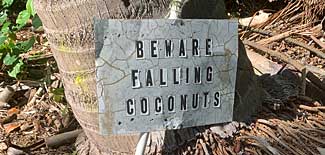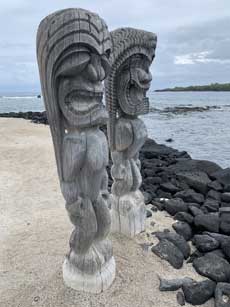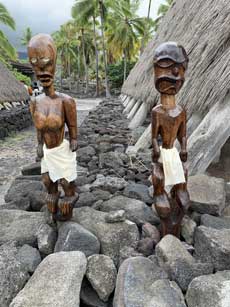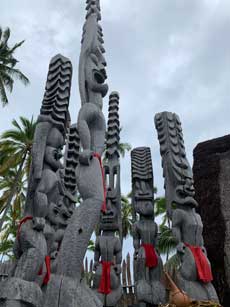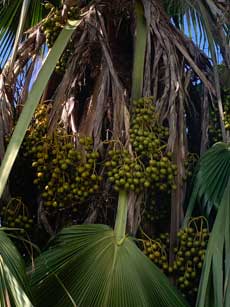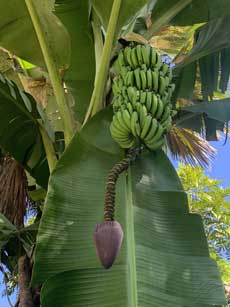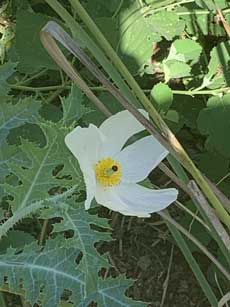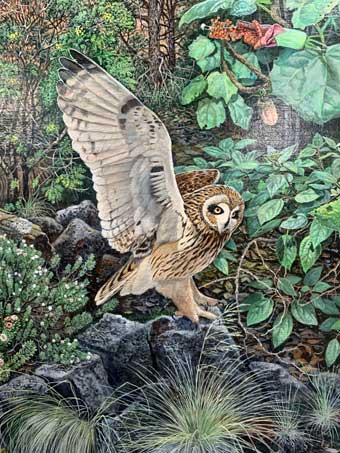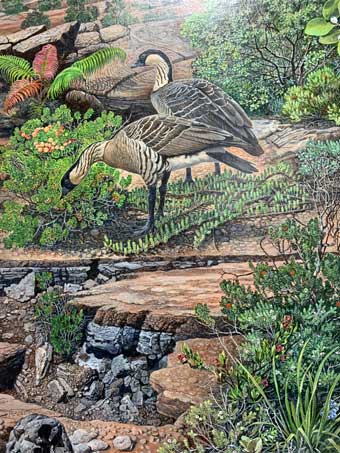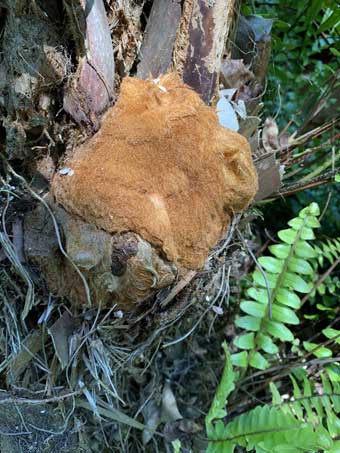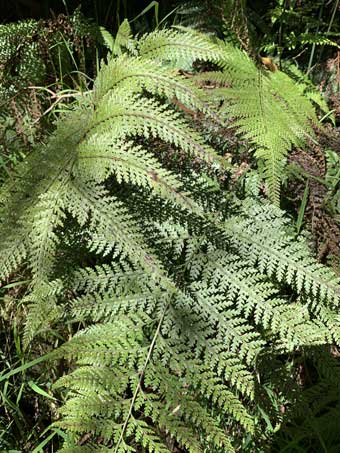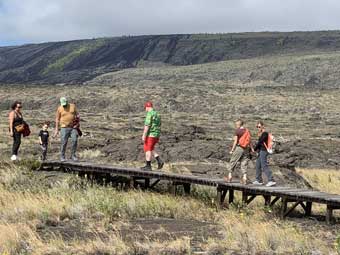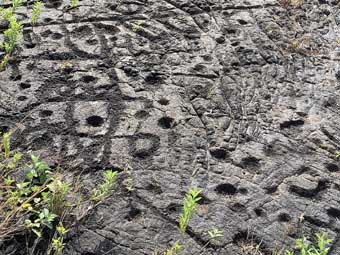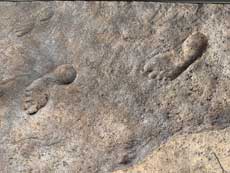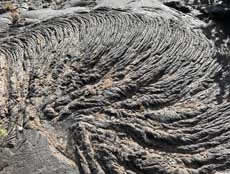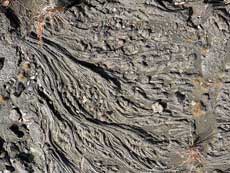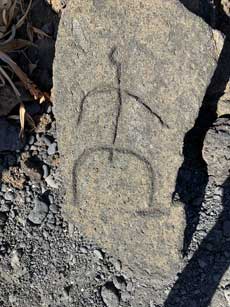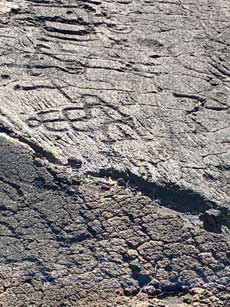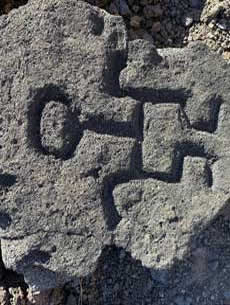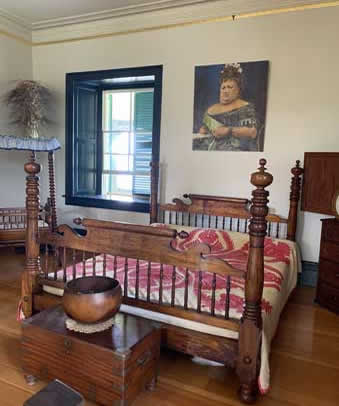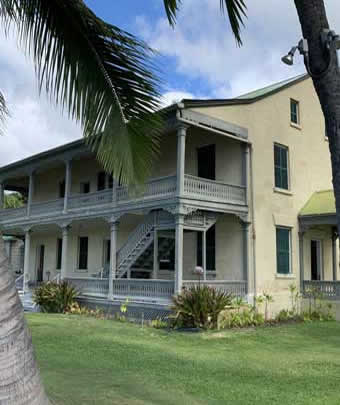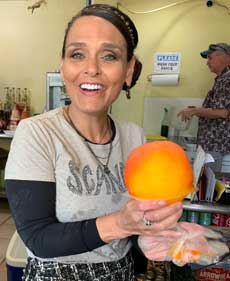| |
|
| |
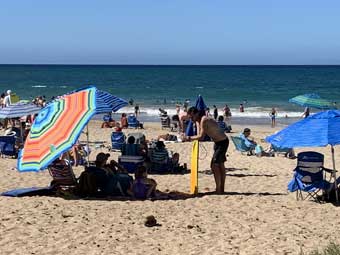 |
|
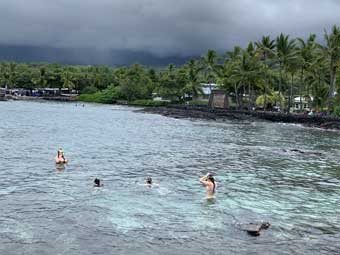 |
|
| |
Hanging out on the beach |
|
Swimming and snorkeling at Kealakekua Bay |
|
We snorkeled in the calm waters of a bay, bodysurfed in crashing ocean waters and relaxed in the hotel swimming pool.
But the watery diversions weren’t the only highlights of our 10-day visit to the Big Island of Hawaii. Every day we – my daughter Molly, her husband Andy, and my partner Liane – went hiking, several times in the ragged lava landscape of Hawaii Volcanoes National Park, other times along coastal areas that were home to early Hawaiians, or through lush, verdant gardens.
We found time to kick back and relax, sometimes visited friends, including Vicky Andersen, a High On Adventure co-contributor and long-time downhill skiing buddy. She and her husband, Ron, relocated to “Paradise” a year ago. (See her story in this issue.) Another day was spent with Krista Olson, owner of Ola Mahina Gardens, a “lettuce farm” that also grows coffee beans. While there, Andy pruned while Molly and Liane helped package bags of Krista’s variety of Kona coffee.
| |
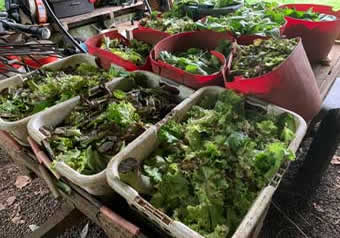 |
|
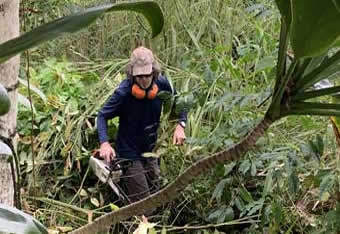 |
|
| |
Picked at the lettuce farm |
|
Andy pruning bushes and trees |
|
I’ve visited and explored the Big Island of Hawaii at other times, but this was different. Instead of relying strictly on guidebooks and whimsy, we relied on Molly who was our foursome’s unofficial guide. She had worked on the Big Island several years ago and has maintained her friendship with Krista and others over the years, often making extended visits. Her and Andy’s familiarity with the island and its lesser-seen attractions added new dimensions to our travels.
Among our outings was snorkeling at Kealakekua Bay, near the island’s southern tip. We swam in the protected sections of the bay’s crystalline waters. It was Liane’s first-ever snorkel – but it won’t be her last. Through our goggles we viewed waters alive with colorful varieties of fish, some snuggled in the mishmash of its bay’s rocky lava bottom, some in schools scurrying hither and thither.
Above water, a mile across the bay is the Captain Cook Monument. Erected in 1874, it’s near the place where Cook was killed. More delightfully, Kealakekua Bay is also a place where spinner dolphins acrobatically burst out of the water and, as their name implies, rotate as they leap through the air.
| |
Sights at Pu’uhonua o Honaunau National Historic Park |
|
Some of the guardians
|
|
Nearby is Pu’uhonua o Honaunau National Historic Park. A well-signed trail from the visitor center led us on a loop walk past numbered posts through the Royal Grounds and the Pu’uhonua. Highlights included the Great Wall, which stands 12-feet high and is 18-feet thick, and wooden images of gods that guard the Hale o Keawe Heiau, a sacred temple. A portion of the walk fronts a protected, black lava rock shoreline that years-ago thwarted boats, including those of invaders, from approaching or attacking from the ocean.
We enjoyed a different kind of swimming at Kekaha Kai State Park, just north of the Kona International Airport. The broad beach offered places to wander in waters close to shore, venture further to bodysurf or ride surfboards. It had been years since I’d bodysurfed, but after my muscle memory was jogged, I managed to catch a few easy waves.
| |
Ulu provide dye from flowers.
|
|
A bunch of bananas
|
|
Koki’o plants provide dye from flowers and bark. |
|
Nearly every day included hiking. Some trails wound through the forested and rough landscapes of Hawaii Volcanoes National Park, some to petroglyph sites, others through gardens alive with flowering plants and a variety of bushes and trees.
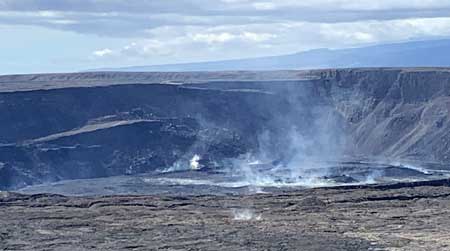
Steam rising from Halema’uma’u
On one of those jaunts we hiked with Molly and Andy from what is now road’s end on Crater Rim Drive West at Uekahuna. On a visit years ago I drove around the entire Rim Drive, but now much of it has been closed since the Halema’uma’u Crater began emitting nasty gases. A crater-within-a-crater, Halema’uma’u is the home of Madame Pele, the Hawaiian volcano goddess. From road’s end at Uekahuna, we hiked a section of the Crater Rim Trail to the Kilauea Overlook and, on the drive back to the park’s Kilauea Visitor Center, stopped at Wahinekapu, the Steaming Bluff, where steam rises from Halema’uma’u.
| |
Murals at the Kilauea Visitor Center |
|
Once back at the Hawaii Big Island murals at the Kilauea Visitor Center, we set out to traipse another section of the Crater Rim Trail along the Waldron Ledge and Kilauea Iki trails before descending down-down to Kilauea Caldera’s bottom. A half-mile section follows Uealoha, or the Byron Ledge Trail, over a 1974 lava flow. From trail’s end it was up-up the Halema’uma’u’s Trail back to the visitor center. After seeing the then-boiling sight, Mark Twain wrote, “The smell of the sulphur is strong but not unpleasant to a sinner.”
| |
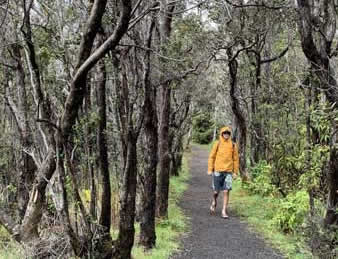 |
|
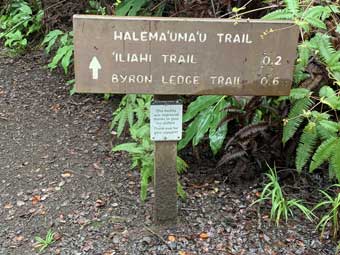 |
|
| |
Hiking the Halema’uma’u trail |
|
Signs show the way |
|
During our four-night stay in Volcano Village we also followed the appropriately named Chain of Craters Road. We stopped to view the Kilauea Iki from an overlook that peaks into the crater, where a “bathtub ring” shows where the lava rose before receding. Another stop was for a loop hike through the always-fascinating Thurston Lava Tube, which is partially lighted by natural light, requires no ducking or scooting, and is said to reveal the “interior of lava plumbing.”
| |
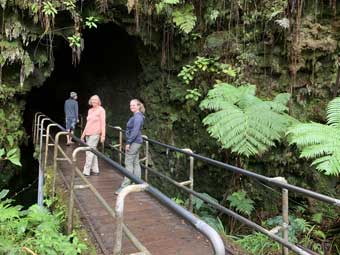 |
|
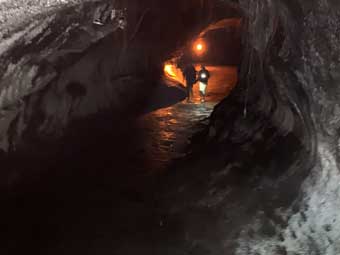 |
|
| |
Entering Thurston Lava Tube |
|
Semi-darkness inside Thurston Lava Tube |
|
A lesser-visited but totally immersive trail just outside the national park is the Kipuka Puaulu, or Bird Park Trail. We followed the mile-long loop trail through a kipuka, an old-growth forest ringed by newer lava flows. As we followed Molly, who learned about the park while working as a botanist, we sometimes wandered off-trail through a fragrant, dense forest of koa trees. Near the parking area was a roadside tree mold, a hole in the surface of hardened lava where a tree once stood.
| |
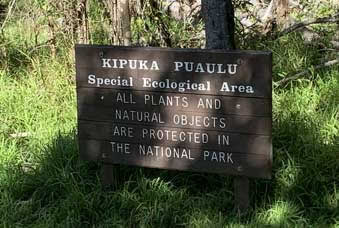 |
|
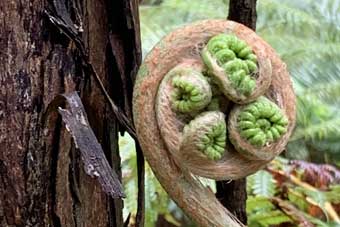 |
|
| |
The ‘Bird Park’ Trail |
|
Fiddleheads (Hapu’u pulu) |
|
| |
Soft pulu, or golden wool
|
|
Palapalai, scented ferns, decorate altars to goddess of hula |
|
Other memorable trails led to petroglyphs, prehistoric rock carvings, some in the forms of humans, turtles, and canoes.
The Pu’uloa Petroglyph Trail goes across an old lava flow with cairns making the way. The largest petroglyph trail in Hawaii – it’s said there are more than 23,000 images - features a circular boardwalk from which to view the petroglyphs and prevent people from walking on them. A lesson we learned, and applied, is to walk both clock- and counter-clockwise around the boardwalk to see carvings from different perspectives. Many at Pu’uloa are small holes that were bored into rock by native parents who tucked umbilical cords from newborn babies into them for good luck.
| |
Footprints |
|
Whirling dervish patterns |
|
The Kau Desert Trail featured a stop at Footprints. Stories of how the petroglyphs were created vary, but some say the footprints were possibly made by people who walked, or ran, through the desert while Kilauea was erupting. Equally, and often even more fascinating, are the acres of a’a and pahoehoe ropey lava flows - bent, twisted and molded into wonderfully weird patterns. But even in this harsh environment, life survives with plants sprouting from cracks in the lava.
| |
Ki’i Pohaku path showcases a variety of petroglyphs |
|
At Kaloko-Honokohua National Historic Park, where a trail parallels the Pacific Ocean and Honokohau Bay past the Ai’opio Fishtrap to the Aimakapa Fishpond, a side trail led to a lollypop loop around Ki’i Pohaku, or petroglyph path.
| |
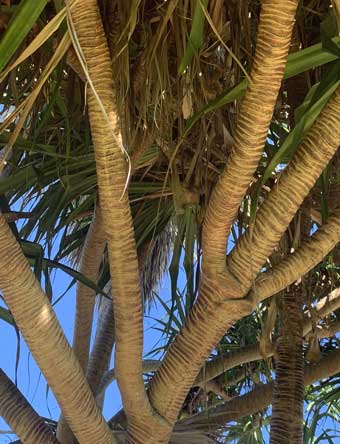 |
|
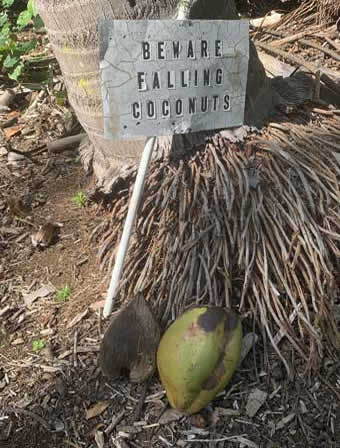 |
|
| |
One of many fascinating trees |
|
Warning sign at Greenwell Garden |
|
On another day, several hours passed quickly as we roamed the Amy B.H. Greenwell Ethnobotanical Garden marveling at plants - koa, ohi’a, pili, makaloa, ulan, kalo and more – along with coconut (Beware Falling Coconuts), ula, and “hula” trees.
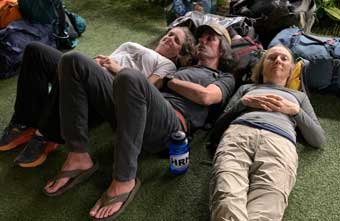
Waiting for a plane that never came
We had more adventurous outings, including an unplanned night at the Kona International Airport as we waited for a midnight flight home. An initial 20- to 30-minute delay extended to nearly three hours and then was cancelled until the next day.
| |
Inside and outside Hulihe’s Palace |
|
| |
|
|
This was frustrating, but the good times were plentiful including time in downtown Kona spent wandering through a farmer’s market, exploring shops, touring Hulihee’s Palace, swimming in Kailua Bay and, yum-yum, sampling varieties of shave ice.
Our days were deliciously full and, like the shave ice, disappeared far too quickly. It was a wonderful time in Paradise. |
|
| |
Time for shave – yummers! – ice! |
|
|
|
About the Author
| |
Lee Juillerat is a semi-retired writer-photographer who lives in Southern Oregon. He is a frequent contributor to several magazines, including “Southern Oregon Magazine,” “The AG Mag,” “Range,” and “The Cattle Mag.” He has written and co-authored books about various topics and places, including Crater Lake National Park and Lava Beds National Monument, and, most recently, “Ranchers and Ranching: Cowboy Country Yesterday and Today.” Lee has produced photo-stories for High On Adventure for more than 20 years. He can be contacted at 337lee337@charter.net. |
|
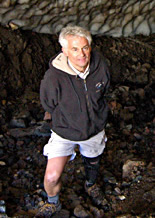 |
|
|
|
|
